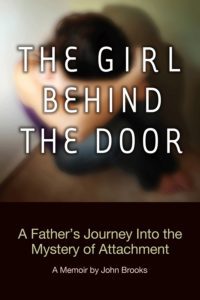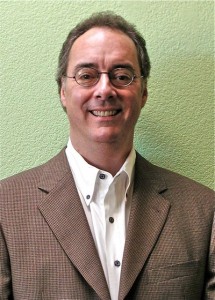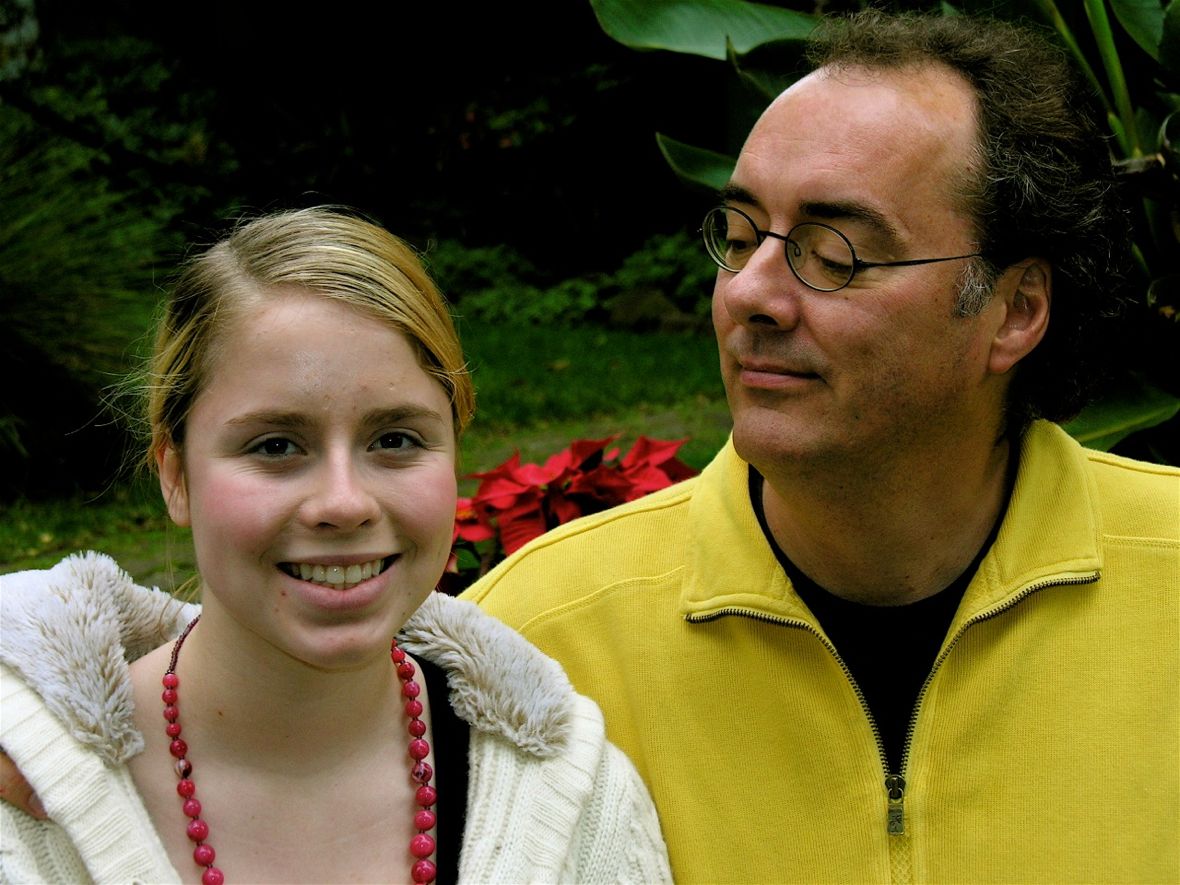I’m so excited and honored to launch this new feature—Writing for Change—with John’s story. He lost his daughter, Casey, to suicide in 2008. He has since become an advocate for suicide prevention, and shares Casey’s story in his book, The Girl Behind the Door.
My family had a pretty blessed life by most standards—a beautiful place to live, a good job, wonderful friends and family.
It wasn’t without its ups and down, but by any measure we were incredibly lucky. Then one weekend in January, 2008, my wife and I had a big fight with our 17-year-old daughter, Casey. Parents fight with their teens. But the next morning I woke to a note:
The car is parked at the Golden Gate Bridge. I’m sorry.
In the early morning darkness Casey had driven to the bridge, jogged out onto the span and leapt, disappearing into the frigid bay along with our hopes and dreams for the future. My heart and soul weren’t just broken, they were smashed to bits.
There are few, if any, things worse than losing your only child to suicide. I simply wanted my life to end that day, to go to sleep and not wake up the next morning. There was no way we could survive this. I lost all interest in things that ‘mattered”—money, work, people, stuff, the future.
Many parents who’ve lost children are compelled to do something to keep their memory alive. Witness the most recent shootings in Santa Barbara, California, and Newtown, Connecticut, to name a few. Parents start foundations. They become advocates and lobby for change.
I became an advocate and lobbyist for suicide prevention. But I also needed to share Casey’s story, so I wrote a book, The Girl Behind The Door.
The Compulsion to Write About My Daughter’s Suicide
I did it all—went into advocacy, changed jobs, made speeches, launched into a new hobby, withdrew into myself—even certain things that were intentionally self-destructive. In the aftermath of Casey’s suicide, my mind was a toxic stew of grief, guilt, thoughts, feelings, remembrances and regrets that I had to organize and get down on paper.
My wife and I visited a medium (not uncommon among parents who’ve lost children). She shared with us a vision of Casey writing on her hand. She was referring to handwriting, a way to communicate.
Casey was a gifted writer. It became clear through that session that Casey wanted to help me write her story from a father’s perspective in order to help others who were incapacitated by grief, as I was. So writing became my natural outlet.
Getting the Story Down
As a finance guy, I was used to writing business reports and financial prospectuses—direct, dry and to the point. I’d rarely written for pleasure or self-expression, although I considered myself a fairly good writer.
The key to bringing this book to life was joining a memoir writing class hosted by a Bay Area newspaper columnist and published author who had a particular gift for envisioning the stories we couldn’t see because we were too close. The bonus was that every class had between six to 12 students, all of them excellent writers and each with a great story. So it was like having multiple teachers and mentors in the room together. At first, I was very intimidated. After all, these people were pros; I was a rookie. But I soon discovered that I could hold my own with all of them.
Since I’d lost my banking job in the financial meltdown of 2009 (a year after Casey died), I was relieved; work seemed meaningless. But I had time on my hands and needed structure to keep from imploding. So I dove obsessively into writing.
My first draft was 450 pages. It was all about me, a grieving father. It took some frank critiquing from my writing class to convince me that the average reader would be worn out from so much grief. They were right.
With their help, I turned the entire story around to focus on Casey—why did she jump, what did everyone miss, what could we have done differently? The story became a “prescriptive memoir” so that other parents could learn from our experience—precisely what Casey had intended from our session with the medium. It was also edited down to about half the original length. After about three years, I was ready for publication.
Many people have asked if the experience was cathartic, therapeutic. The answer is complicated. It wasn’t therapeutic in the sense that it was a magic balm for my crushed heart and soul. That will probably never happen; it’s something I’ll live with forever. But the writing process did keep me focused and distracted from the blackness of Casey’s loss, something that otherwise would’ve overwhelmed me. So for that I’m very grateful.
Writing Gave Me a Purpose
Honestly, I can’t say that I feel dramatically different now than I did before I started writing. But the process gave me purpose and I’m very proud of the finished product—everything from the story itself to the layout to the cover.
Seeing consistently excellent Amazon reviews, and receiving even more encouraging emails from others who were profoundly touched by Casey’s story, has been incredibly gratifying and validating for this rookie writer. This was to be my contribution toward keeping Casey’s legacy alive forever, and I think I succeeded. But these feeling are fleeting. With my precious Casey gone I still struggle with a life without her.
The Path to Publication
When I first began the search for an agent I was prepared for rejection, and I wasn’t disappointed. Memoirs are a hard sell, especially with specialized subject matter like adoption. So I expected to go straight to self-publishing.
The typical agent response was, in effect: “So sorry for your loss. The story is too sad. No one will read it, even if they should.” They probably never read past the first chapter. One agent actually signed me up, herself adopted. But after six months of shopping, the same response: “Too sad.”
Back to plan A—self-publish.
Though I was extremely happy with the final product from the self-publishing process, I then ran into another hurdle as I tried to reach an audience. Editors, hosts, columnists, reviewers and producers have a built in bias against self-published books as they are deemed “not legitimate.” That barrier alone shut me out from a crucial marketing channel—the media.
So I focused on affinity groups, social media, blogging, local sources (e.g. local community newspapers and radio) and relentless word of mouth, imploring everyone to post a word or two to add to my Amazon reviews. Still, competing titles with “real” publishers and representation gain access to the media megaphone and bookshelves and sell a lot more books.
What has been most encouraging to me has been the steady stream of reviews, Facebook messages and emails from readers, and I respond to every single one. I’m convinced that many more people would love Casey’s story if only they knew it existed. So my challenge now is to find those channels that will help lead me to more readers.
Advice for Others Called to Write
At the moment I’m trying to support a friend in writing his own story about losing his son to the Golden Gate Bridge just two weeks after Casey jumped. He has a very powerful voice but wastes too much time on Facebook and unproductive activities. Like me, he has time on his hands, but the main challenge is getting started.
Sitting down to write a book is an intimidating experience for the uninitiated. You have to get over the initial writer’s block and just start writing, anything and everything, even if you don’t know where the story is going. You’ll sort through it later.
I found my writing group absolutely crucial to keeping me focused and motivated, and would urge anyone to join up. It is terribly difficult to do this on your own. Writers seem to need constant reassurance.
What Readers May Learn from Casey’s Story
All too often we entrust our troubled loved ones with “professionals” with degrees and years in practice. We never question their expert opinion and follow their advice precisely. Unfortunately, sometimes they get it wrong.
That being said, it is crucial (and not easy) to get the right kind of help from someone qualified to know which questions to ask and how to ask them. A proper diagnosis is also crucial. You need a professional adept at seeing the difference between disorders that oftentimes look the same. If your loved one isn’t properly diagnosed, they can’t be properly treated or medicated.
* * *
 The Girl Behind the Door: A father embarks on a journey to understand what led his daughter to take her life. He travels back to her abandonment at birth and adoption from a Polish orphanage. His search leads to attachment disorder, common among children who’ve been abandoned, neglected or abused. It explained everything. The Girl Behind The Door integrates a tragic personal adoption story with information from the experts to teach other families what the Brookses learned too late. Available at Amazon.
The Girl Behind the Door: A father embarks on a journey to understand what led his daughter to take her life. He travels back to her abandonment at birth and adoption from a Polish orphanage. His search leads to attachment disorder, common among children who’ve been abandoned, neglected or abused. It explained everything. The Girl Behind The Door integrates a tragic personal adoption story with information from the experts to teach other families what the Brookses learned too late. Available at Amazon.
Find more information about Casey’s story and The Girl Behind the Door:
 John Brooks was a senior financial executive in the broadcast and media industry until tragedy struck. Since his daughter, Casey’s, suicide, he has turned to writing, mental health activism, speaking engagements, lobbying for a suicide barrier on the Golden Gate Bridge (the deadliest structure on Earth for suicide), and he leads a teen group that speaks at Marin County, CA. schools about depression and suicide. He also maintains a blog (see above) where he shares his lessons learned about adoption, attachment parenting and therapy techniques. Mr. Brooks has been featured on the Dr. Phil Show, NPR-affiliate, KQED-FM, the San Francisco Chronicle and the Marin Independent Journal, as well as other regional and local media outlets. Casey’s story has also appeared in San Francisco Magazine.
John Brooks was a senior financial executive in the broadcast and media industry until tragedy struck. Since his daughter, Casey’s, suicide, he has turned to writing, mental health activism, speaking engagements, lobbying for a suicide barrier on the Golden Gate Bridge (the deadliest structure on Earth for suicide), and he leads a teen group that speaks at Marin County, CA. schools about depression and suicide. He also maintains a blog (see above) where he shares his lessons learned about adoption, attachment parenting and therapy techniques. Mr. Brooks has been featured on the Dr. Phil Show, NPR-affiliate, KQED-FM, the San Francisco Chronicle and the Marin Independent Journal, as well as other regional and local media outlets. Casey’s story has also appeared in San Francisco Magazine.

